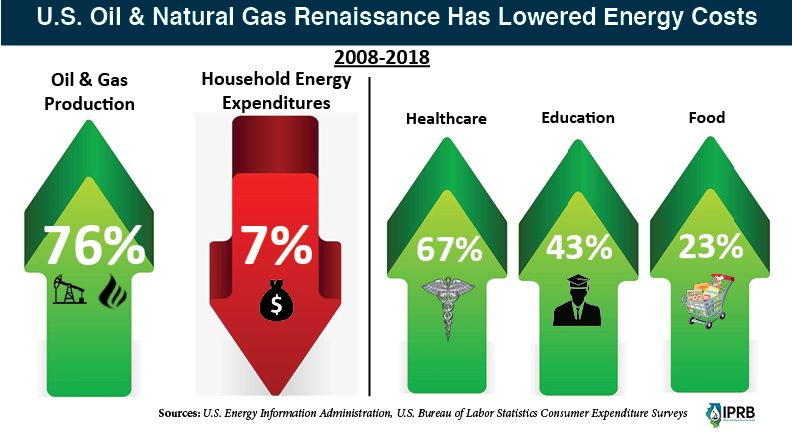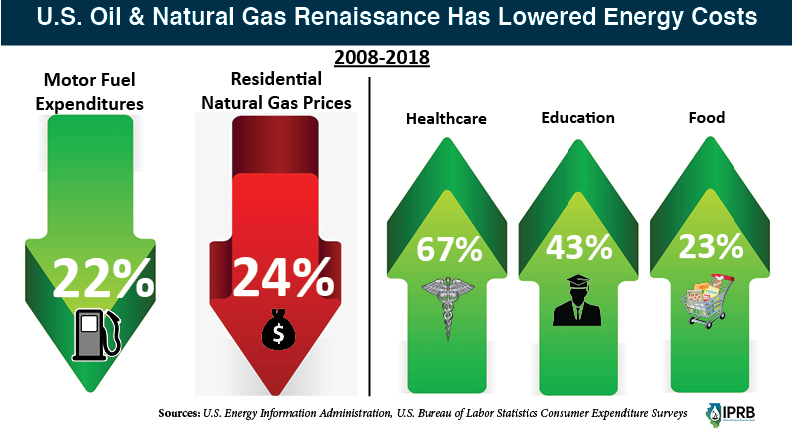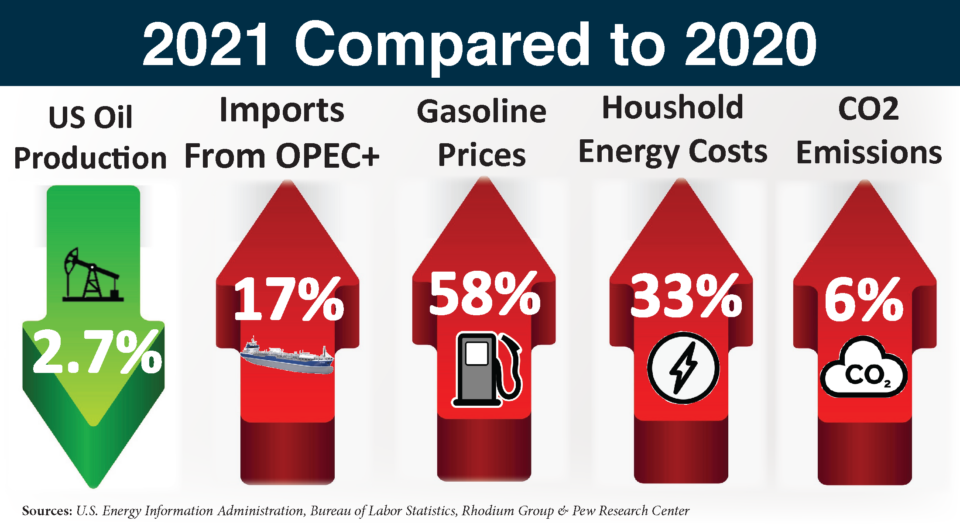*UPDATE* Strong U.S. Oil and Gas Production Keeps Energy Costs Affordable
UPDATE: Jan. 14, 2022
Numerous recent reports show that energy costs increased dramatically in 2021, as U.S. oil and natural gas production was unable to keep up with surging demand.
CNBC reported in December that the most recent Bureau of Labor Statistics data show that energy prices increased 33.3 percent in 2021. Gasoline prices specifically were up a whopping 58 percent in 2021, according to the Pew Research Center.
The sudden and sharp increase in energy costs after more than a decade of consistent declines has taken a heavy toll on American households, particularly low-income families. CNBC reported that a recent study by Help Advisor finds that 20 percent of Americans couldn’t pay at least one monthly energy bill in full last year, while 18 percent kept the temperature in their home at an unhealthy or unsafe level. More than a quarter of Americans sacrificed food or medicine in order to pay an energy bill, according to the Help Advisor report.
Ironically, policies aimed at decreasing U.S. oil and natural gas production in an effort to lower greenhouse gas emissions actually contributed to a six percent jump in carbon dioxide (CO2) emissions, as utilities burned more coal due to less plentiful and more expensive natural gas.
As the Rhodium Group concluded in a December report:
“GHG emissions rebounded slightly faster than the overall economy in 2021, largely due to a jump in coal-fired power generation…
“With only modest growth in overall electric power demand in 2021 (up 3% from 2020), the more robust growth in power sector GHG emissions was due to a sharp rise in coal generation, jumping 17% in 2021.”
UPDATE: June 3, 2020
A new Consumer Energy Alliance (CEA) report finds record U.S. natural gas production saved Illinois consumers $24 billion from 2007 to 2017, an average savings of $876 for every resident in the state. The report also finds that residential natural gas prices in Illinois were 25 percent lower in 2017 than they were 10 years prior, due largely to a dramatic increase in domestic production over that time-frame.
According to the report, roughly 1.6 million Illinoisans who are living below the poverty line spend about a quarter of their income on energy costs, placing added significance to the savings that have been made possible by cheap and abundant natural gas. The CEA finds that 80 percent of Illinois households use natural gas to heat their homes during the winter and that natural gas is also essential to the agricultural, manufacturing and utility sectors.
Check out a fact sheet on the report here.
Original Post: April 15, 2020
The cost of living in the United States has increased across the board over the past decade, with one notable exception. At the same time healthcare, education and food costs have exploded (see graphic below), the most recent government data show household energy costs – including utilities and expenditures on transportation fuels – were down just under seven percent from 2008 levels in 2018, the latest year in which data is available.
Considering 68 percent of America’s energy needs are met by oil and natural gas, the decline in overall energy costs can be traced to the fact that domestic oil and natural gas production increased 76 percent during that time-span.

As a result, the typical American family of four has saved $2,500 per year, according to the White House Council of Economic Advisers. Those savings make a huge difference for low-income households, which have historically spent a disproportionate amount of their incomes on energy, making energy price spikes disproportionately impactful as well (more on that in a bit).
Access to affordable and abundant energy is a fundamental need – and the U.S. oil and natural gas industry has met that need in a big way, reversing a troubling trend in the process.
Back in 2008, talk of “peak oil” and “peak gas” was commonplace. Domestic production was perceived to be in irreversible decline and imports were surging to all-time highs. Not coincidently, U.S. energy costs “reached their highest point on record in 2008, when they averaged $24.13 per million Btu,” according to a 2018 U.S. Energy Information Administration (EIA) report.
But thanks largely to industry innovation, the United States is now the world’s largest oil and natural gas producer, and energy costs have plummeted as a result. The EIA reported that in 2016, U.S. energy costs fell to a “record-low energy expenditure share,” adding:
“The U.S. average energy price was $15.92 per million British thermal units (Btu) in 2016, down 9% from 2015, and the lowest since 2003, when adjusted for inflation.”
U.S. households today spend less than four percent of their total budgets on energy costs, down from 5.1 percent a decade ago. Gasoline prices are currently about half of the record-high costs seen in 2008 and have averaged below $3 a gallon for six straight years, while retail natural gas prices declined 24 percent from 2008 to 2018.

However, oil and natural gas bans and restrictions being proposed by mainstream political factions pose a real threat to energy access and affordability moving forward. Such policies would negatively impact a large portion of the population if implemented.
A 2018 Energy Information Administration (EIA) report reveals that one of three U.S. households struggle with household energy insecurity, meaning that although they have adequate access to energy, they oftentimes can’t afford it. In fact, 25 million Americans report they’ve had to choose between energy and food or medicine in 2018, while 14 percent of those surveyed reported they had recently received a disconnection notice.
It is with those facts in mind that several civil rights leaders have advocated for access to natural gas for low-income minority communities, in addition to declining to endorse bans on hydraulic fracturing. As Axios recently reported:
“Revs. Al Sharpton and Jesse Jackson and National Urban League President Marc Morial said energy costs are hitting people of color unfairly hard. These concerns, expressed before the coronavirus pandemic, are poised to expand as paychecks shrink across America.”
As Energy In Depth recently highlighted, Rev. Jackson has worked with local officials in the Pembroke Township community of Hopkins Park – one of Chicago’s poorest suburbs – to bring a natural gas line to the community. The median income in this Chicago suburb is just $16,000 per year and residents have relied primarily on propane and wood stoves for home heating during the region’s often brutal winters.
As Energy In Depth noted, “Why natural gas? Households that use natural gas saved more than $4,000 over a 10-year period, according to a recent study by Shale Crescent USA and the Ohio Oil & Gas Energy Education Program. Low income households, which spend a disproportionate amount on energy, realized savings equal to 2.7 percent of their annual income.”
Hopkins Park Mayor Mark Hodge said in a recent TV interview that:
“This community has been overlooked for the past 48 years for natural gas, so we’re in need of industry and we’re in need of jobs, and our school is in need of natural gas.”
In the real world, access to affordable, reliable energy is a far bigger priority than idealistically driven renewable energy campaigns that deliver neither. Fortunately, America’s oil and natural gas industry is meeting those fundamental needs.

